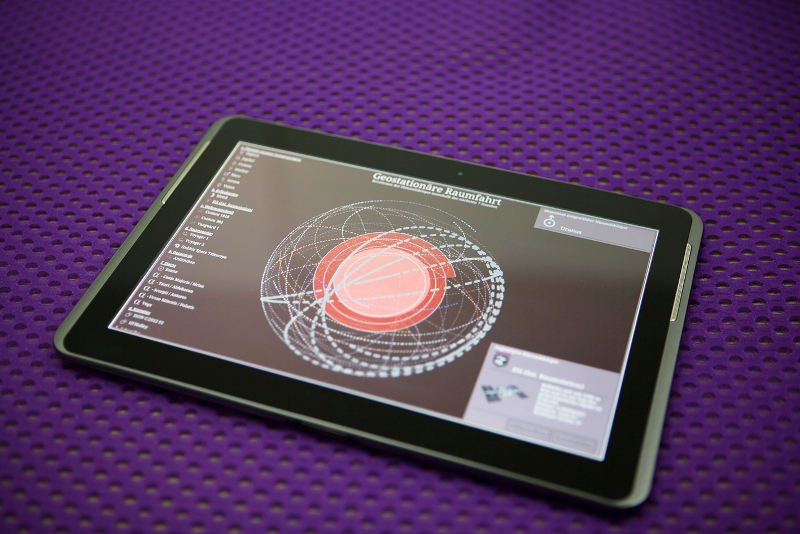geostationary space travel
Installation, 2013
Summary
A bed that rotates in harmony with the orbits of celestial bodies (planets, stars, space junk etc.) from inside or outside of our solar system. According to the desired selection of the passengers, the bed navigates to the current position of the selected celestial body and keeps following its orbit in real-time. The lying/sleeping person will follow the orbit of the celestial body until a new celestial body is selected from the menu.

Mission statement
Subseqent to the first images from the dark side of the moon (Lunik 3, 1959), the immediate exploration of the cosmos continues. So far the reachability of celestial bodies had been a problem of cosmonautics. The question if dreams not only influence our thoughts and feelings is still in need of an explanation.
By mutating human organs of perception and through the prosaic arithmetic pursuit of all apparent laws of nature and difficulties of imagination, the present work would like to contribute to the finding that the universe never sleeps:
It will be possible to spend a night in the orbit of various celestial bodies, e.g., in the orbit of Mercury, the fastest planet of our solar system, or in the orbit of the toolbag that Heidemarie Stefanyshyn-Piper lost November 18, 2008 during maintenance work at the International Space Station.
This voyage is made possible by a rotating bed that serves as an apparatus to increase the capacity of the natural sensory organs of homo sapiens. Beside the bed, there is a monitor, on which a user-defined celestial body (planet, satellite, space junk etc.) from inside or outside of our solar system can be selected.

|

|
According to your selection, the bed navigates towards the current position of the selected celestial body and keeps following its orbit in real-time. The lying/sleeping person will follow the orbit of the celestial body until a new celestial body is selected from the menu.

By booking in advance people could spend a full night within the period of the exhibition. The day after the passengers got picked up for a space breakfast and had to file a report of their experiences.
Reports from passengers:
MISSION OPERATION REPORT
January 24-25, 2013
------------------------------------------L.&N.-----------------------------------------
> Which celestial body was selected?
Ursa Major durong the first part of the night, followed by no selection.
In the morning Scorpio was followed.
> Why was the celestial body selected?
Ursa Major: because we didn't want to sleep with the head towards the window and
furthermore because Ursa Major is a celestial body that is moving quite a bit
Scorpio: zodiacal sign
> How did you sense the orbit you were in?
First of all the circular bed in the empty room is quite nice.
It's somehow strange to be moved during sleeping. You're exposed to this movement in
almost the same manner as we terrestrials are exposed to the earths' movement - perhaps
more connected than exposed. Even though I've been moving concurrently while sleeping.
In retrospect I became aware of the existence of the stars moving constantly around us.
Usually I don't spend time thinking about the existence of the universe.
> What could you do, what not?
Both of us could sleep ... though during the night we once had trouble operating the bed.
January 25-26, 2013
------------------------------------------az@z------------------------------------------
> Which celestial body was selected?
Mercury
> Why was the celestial body selected?
It moves fast, but not too fast.
> How did you sense the orbit you were in?
Sublime. I dreamt (see sleep-wake cycle). It was kind of cool: after waking up and first
opening my eyes, next I was trying to relocate myself in space.
> What could you do, what not?
Because of the low temperatures I couldn't really enjoy it.
Sleep in peace because of the noisy passerbys (Friday night)
January 26-27, 2013
-------------------------------Plutina Platina-------------------------------------------
> Which celestial body was selected?
Jupiter
> Why was the celestial body selected?
Due to the predictions of a this years kiosk horoscope
> How did you sense the orbit you were in?
Very pleasant voyage. A feeling of free and weithtless spinning!
> What could I do, what not?
The space travel passed almost too fast! I could only fly over all of the provided
non-fiction literature.
A feeling of deceleration emerged with the exclusivity of the experience, though I
wouldn't mind if it would last longer in realtime!
January 27-28, 2013
-------------------------------Mirjam & Christian-------------------------------------------
> Which celestial body was selected?
Sun, because you wake up with your head towards the light.
> Why was the celestial body selected?
As a result of the prediction of a very cold night.
> How did you sense the orbit you were in?
Perfect dreams. About flying.
> What could I do, what not?
Couldn't sleep without interruptions. I had to check my position at 2 am
[Data]
Images from Wäscherei (zip|8.2MB)
[Presented at]
'geostationary space travel' - Solo exhibition at Kunstverein Wäscherei from January 24-27. 2013, Zürich, CH.
'Hagulane' - Group exhibition, 29.June-31.August 2014, municipal gallery Villingen-Schwenningen, BRD.
[Technology]
Wood, textiles, various electronics and software
Photos courtesy of Thorsten Strohmeier
